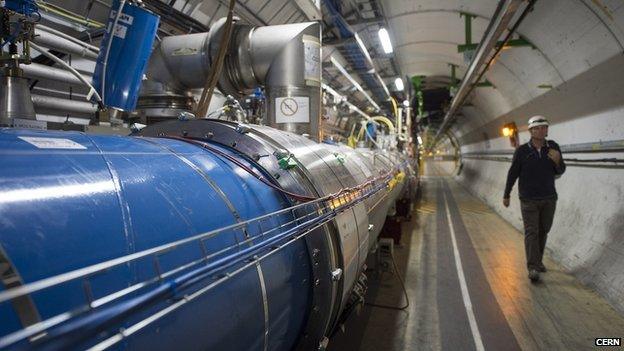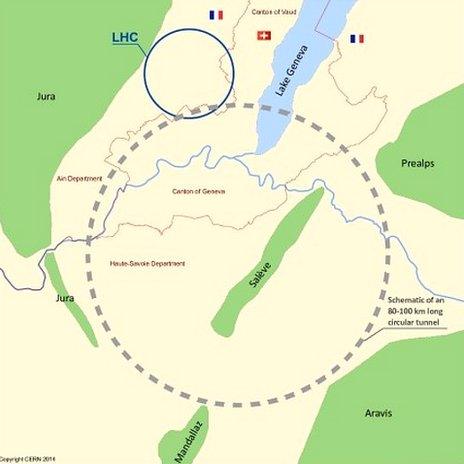Cern considers building huge physics machine
- Published

The current tunnel housing the Large Hadron Collider is some 27km long
The possibility of building an underground "atom-smasher" four times the size of the Large Hadron Collider is to be explored by experts.
The decision follows a high level meeting of scientists last week in Geneva, near the European particle physics centre, Cern.
The proposal is for a 100-km tunnel which would encircle the Swiss city.
It would reach to the Alps in the east, the Jura mountains in the west and even go under Lake Geneva.
Maps showing the proposed route reveal that it dwarfs the existing LHC, which is itself a world record beater as a science facility.
Dr Rolf Heuer, director general of Cern, who opened the meeting, argues it is already time to start thinking about what will follow the LHC, even though that machine has only been running a few years.
"We have very long lead times," he explained, "because our projects are ambitious, and they need a lot of research and development.
"Take as an example the LHC. It is just three years into full swing, but the real discussions on the LHC started in 1983; the first meeting on the physics in 1984. And the first data were taken in 2009. So we need a long lead time. And that's why we start now to kick off this project."
The 100km Cern tunnel is just one of several proposals to be considered following the "kick-off" meeting being held this week. Japan and China are also interested in hosting giant international colliders, though the European advocates argue Cern's established infrastructure would deliver substantial savings, and greater certainty over its success.
As well as the size and location of the collider, the particles to be smashed in it are also hotly debated.
New approaches
Some experts favour colliding protons, as is done in the LHC: Far higher energies can be reached using these, meaning researchers can explore higher extremes of conditions, more closely mimicking the Big Bang.
Paul Collier, head of beams at Cern, says the size of the Geneva basin is fortuitously right for such a machine. The aim is to reach energies about eight times higher than the 27-km-long LHC, at which point cornering round the bends of the tunnel becomes much harder for the speeding protons.
The larger radius and gentler curvature of the 100km tunnel, which just fits between the troublesome limestone either side of the basin, helps somewhat; and steering magnets, under development at Cern now, with twice the power of the LHC's would do the rest.

The hatched lines show the proposed area covered by the new plan
Other experts, however, prefer using electrons, as were fired through the LHC's predecessor, the LEP (the Large Electron Positron collider). These can be steered more easily, and give a far cleaner physics signal, meaning the complexities of interpretation that dog the LHC experiments can be avoided.
As to the value of building any experiment to succeed the LHC, Dr Heuer dismisses any suggestion that the discovery of the Higgs boson marks an end point to particle physics.
"By no means. We've only just begun," he said.
"It took nearly 50 years to complete the so-called Standard Model, which just describes barely 5% of the Universe - the visible Universe. Fifty years for 5%! We still need to explore 95%, and this is what I would call the dark Universe.
"We very much hope that with the LHC running at higher energy next year, we might get the first glimpse of what dark matter is, for example. And building on that I would assume that we then can build a physics case for a future circular collider."
Open questions
For Guido Tonelli, spokesperson for the CMS detector at Cern, when the Higgs discovery was underway, the essence of a physics case already existed.
"In my view - this is different from other scientists - I consider it important to start digging the new collider now, independent of what might be found at the LHC in the next few years," he explained.
"If nothing appears in the next phase of the LHC, we have to move to higher energies, because there we might find solutions to the big questions that are still open.
"If we do find something, we know that at the LHC, we might be able to see the 'tail of the dinosaur', and we would need a machine with much higher energy to see the 'entire animal'. So I accept we don't yet know the details of the next accelerator; but the need for one is clear now."
Rolf Heuer, only half jokingly, suggests the 100km proposal is modest by comparison with the Gothard Base rail tunnel (to run through the Swiss Alps) which is currently nearing completion and has three tunnels each measuring 57km long.
Cern civil engineer John Osborne, agrees the tunnelling shouldn't be complex - using tunnel-boring machines as was done with the Channel Tunnel, the full length could be excavated in five or six years, he estimates. Though he concedes it would produce a lot of material that would have to be disposed of.
"For the LHC tunnel, which was 27 km, we dug up about 1.5 million cubic metres of rock. And for that we managed to find local quarries that we could fill with all the excavated material.
"But for this tunnel, for which we don't know all the dimensions, it would be substantially more - maybe 10 million cubic metres? So we do need to think about the environmental impact, and what we can do with this rock."
Money, money, money
As to the price, no-one was prepared to venture a number. Perhaps because Rolf Heuer sternly advised the 350 participants not to.
"Any number you mention will be wrong," he explained, "and worse it will be remembered forever." And give the proponents a lot of trouble, he implied.
But he hopes to make the proposal affordable, by making a partnership across the world.
To that end, the next phase of the pilot study will be governed by a handful of leading experts from every region, to identify the feasibility of each proposal, identify the technology gaps, and the physics requirements. By the time it reports back, in about five years, the next set of results from the LHC should help settle on a conceptual design for a machine that might be built anywhere.
From there another five years to complete a detailed design, choose a site, and secure international approval and financing. And with 10 years to build and install the equipment, it might just be feasible to have a new machine ready when the LHC retires in 2035. Though the mood at the meeting was that is an optimistic timeline.
Paul Collier, head of beams at Cern, concedes the proposal might seem headstrong, but argues it is the rational route ahead for particle physics.
"There's no point in doing small leaps when you invest in such a facility. If you take little steps, you will not get the value for money," he said.
Another participant, approaching retirement himself, pointed out that the tunnel that now houses the LHC, and previously housed LEP was first discussed 40 years ago, and will still be in use in 20.
Likewise, the future collider will probably go through many incarnations, and still be running in 60 years.
He recalled a proverb he had to translate from Latin as a schoolchild: "He plants the seeds of trees he'll never see bearing fruit."